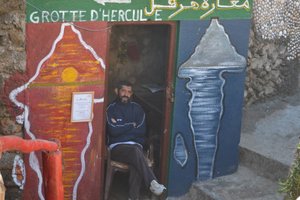Advertisement
Published: January 6th 2012

 Image 1
Image 1
Entrance to The Grottes of Hercules Since last year, I decided to do something different during my birthdate. Last year, I created a group at Facebook – my batchmates when we entered the University of the Philippines at Los Banos (UPLB) in June 1976. As of today, there are close to 200 members and still growing!
This year I joined Travelblog and this is my first entry since joining two days ago and today is also my birthday. I chose to talk about my first visit to Morocco, in Tangier in October 2011 – having the opportunity to see some sights after a 4 day duty travel.
The Grottes of Hercules (Image 1), located some 14 km from Tangier is a magnificent sight (Image 2). Overlooking the Atlantic Ocean, the entrance is flooded with very strong rushing water currents during high tide. From here you can have a glimpse of the Strait of Gibraltar and the Spanish Coast. Local folks says that the place is linked to where Hercules rested after successfully completing his 12 tasks. It is still not known how this cave was formed. You will on the side the walls of the cave decorated with empty bivalve and other shells (Image 3).

 Image 2
Image 2
The Grottes of Hercules Tangier's Medina (old-walled city) is such a bubbly place, with alleys (Image 4, Image 5, Image 6) filled with all sorts of shops, tea-houses, fruits, tourist trinkets, etc. I got 3 pieces of ceramics (Image 7) and a mirror engraved with camel bones (Image 8).
Another beautiful trinket to take away are the Moroccan lanterns and lamps – with brass finish or antique finish which gives a lovely and enchanting effect created by the diffusion of light through the coloured perforated glass. Some are suitable as candle holders (Image 9).
Sharing a photo taken in Tangier, Morocco on October 2011 with beautiful Islamic mosaic art called Zilliji in the background wall. Zilliji is a unique form of mosaic art (images created from small pieces of glass or stone) that has been practiced in Morocco since the tenth century, and these intricate tiling patterns cover the walls, columns and fountains throughout Morocco’s imperial cities. Unique when compared to other styles of mosaic, Moroccan mosaics typically consist of geometric shapes and patterns rather than the portraits or landscapes characteristic of other popular forms of mosaic. The need to create art that inspired meditation, reflection and faith but also fit

 Image 3
Image 3
External walls of the cave decorated with empty bivalve and other shells the confines of Islamic law is very much reflected in the Zilliji. Muslims celebrate art through patterns and complex geometric shapes, which can also be seen in Moroccan textiles and ceramics. Zilliji art artisans mold local clay into small slabs which are then sun dried, painted, fired, and chiseled into a precise geometric shape. Hundreds and thousands of these tiles are then arranged together to form a single work of art – commonly seen as ornamental decorations in mosques, royal buildings, schools, historic sites and homes of the very wealthy. (Ref: Various sources)
Advertisement
Tot: 0.113s; Tpl: 0.011s; cc: 7; qc: 47; dbt: 0.0525s; 1; m:domysql w:travelblog (10.17.0.13); sld: 1;
; mem: 1.1mb

 Image 1
Image 1
 Image 2
Image 2
 Image 3
Image 3














